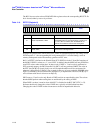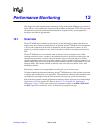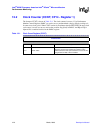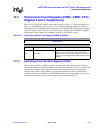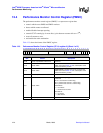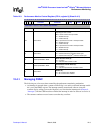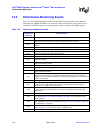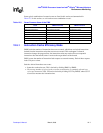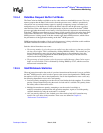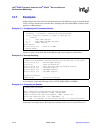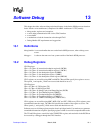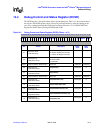
12-8 March, 2003 Developer’s Manual
Intel
®
80200 Processor based on Intel
®
XScale
™
Microarchitecture
Performance Monitoring
12.5.2 Data Cache Efficiency Mode
PMN0 totals the number of data cache accesses, which includes cacheable and non-cacheable
accesses, mini-data cache access and accesses made to locations configured as data RAM.
Note that STM and LDM each count as several accesses to the data cache depending on the
number of registers specified in the register list. LDRD registers two accesses.
PMN1 counts the number of data cache and mini-data cache misses. Cache operations do not
contribute to this count. See Section 7.2.8 for a description of these operations.
The statistic derived from these two events is:
• Data cache miss-rate. This is derived by dividing PMN1 by PMN0.
12.5.3 Instruction Fetch Latency Mode
PMN0 accumulates the number of cycles when the instruction-cache is not able to deliver an
instruction to the Intel
®
80200 processor due to an instruction-cache miss or instruction-TLB miss.
This event means that the processor core is stalled.
PMN1 counts the number of instruction fetch requests to external memory. Each of these requests
loads 32 bytes at a time. This is the same event as measured in instruction cache efficiency mode
and is included in this mode for convenience so that only one performance monitoring run is need.
Statistics derived from these two events:
• The average number of cycles the processor stalled waiting for an instruction fetch from
external memory to return. This is calculated by dividing PMN0 by PMN1. If the average is
high then the Intel
®
80200 processor may be starved of the bus external to the Intel
®
80200
processor.
• The percentage of total execution cycles the processor stalled waiting on an instruction fetch
from external memory to return. This is calculated by dividing PMN0 by CCNT, which was
used to measure total execution time.



